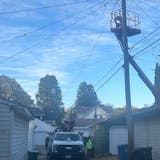St. Paul is about to find out how the do-it-yourself approach to urban rehabbing pays off.
Four long-vacant 19th-century houses in the historic Dayton's Bluff neighborhood are going on the market, thanks to months of renovation work directed not by private developers but by the city's Housing and Redevelopment Authority (HRA).
It isn't a moneymaking venture for St. Paul. The first phase of the project cost $1.2 million, including what the HRA paid for the houses and what it cost to restore them to historic standards and add the amenities that homeowners expect, including two-car garages. The first two houses will be listed for $219,900 and $165,000.
What made it a good investment was the chance to stabilize a neighborhood worth saving, said City Council President Kathy Lantry, who represents the stretch of E. 4th Street between Maria and Bates avenues that is the heart of the Fourth Street Preservation Project.
"We really needed to fundamentally change the balance in the neighborhood … and this opportunity is not going to come around again," she said.
Change already was evident this week, as a work crew for Hugo-based Charles Nosie Construction put finishing touches on a gray Italianate-style two-story with mustard trim at 326 Maria.
Project manager Bruce Boudreau said the job had been a challenge because of the customized millwork and other details the city required to maintain the house's 1879 character. He said those details have extended the work, prompting the HRA to fine Nosie $100 for each day beyond the agreed-upon June 15 end date.
"But it's nice to see it done," Boudreau said. "It's going to really bring the culture back to the neighborhood."


